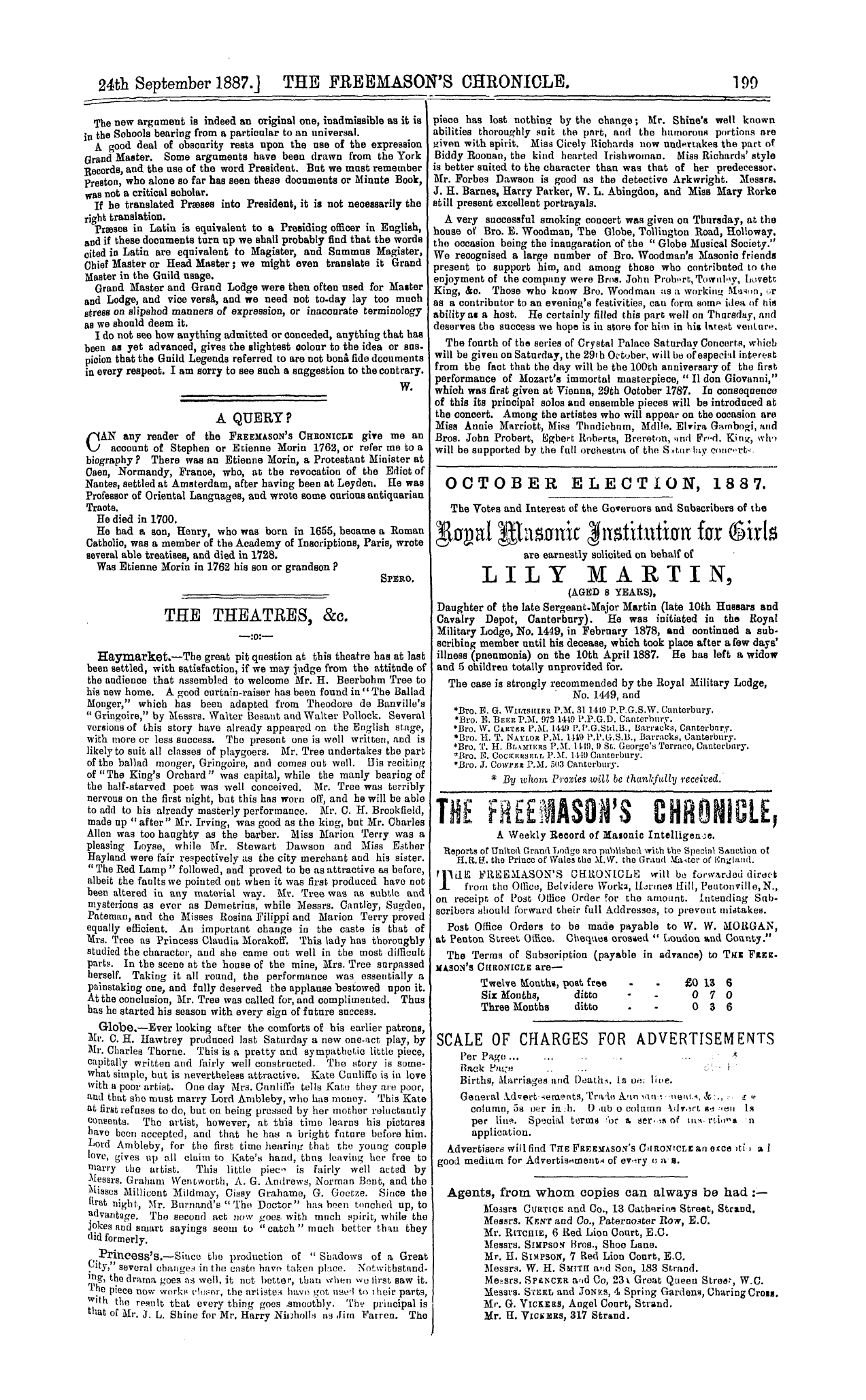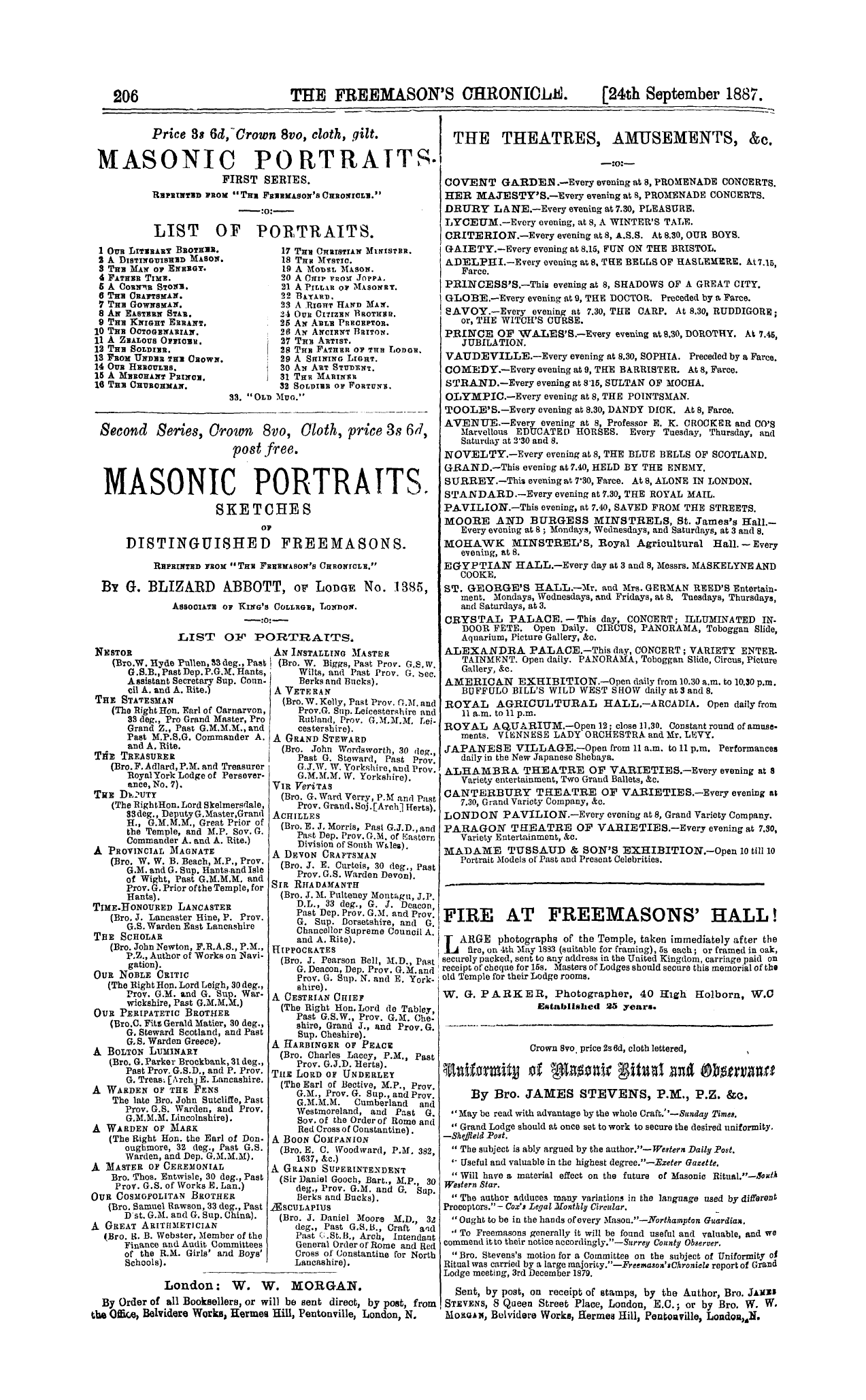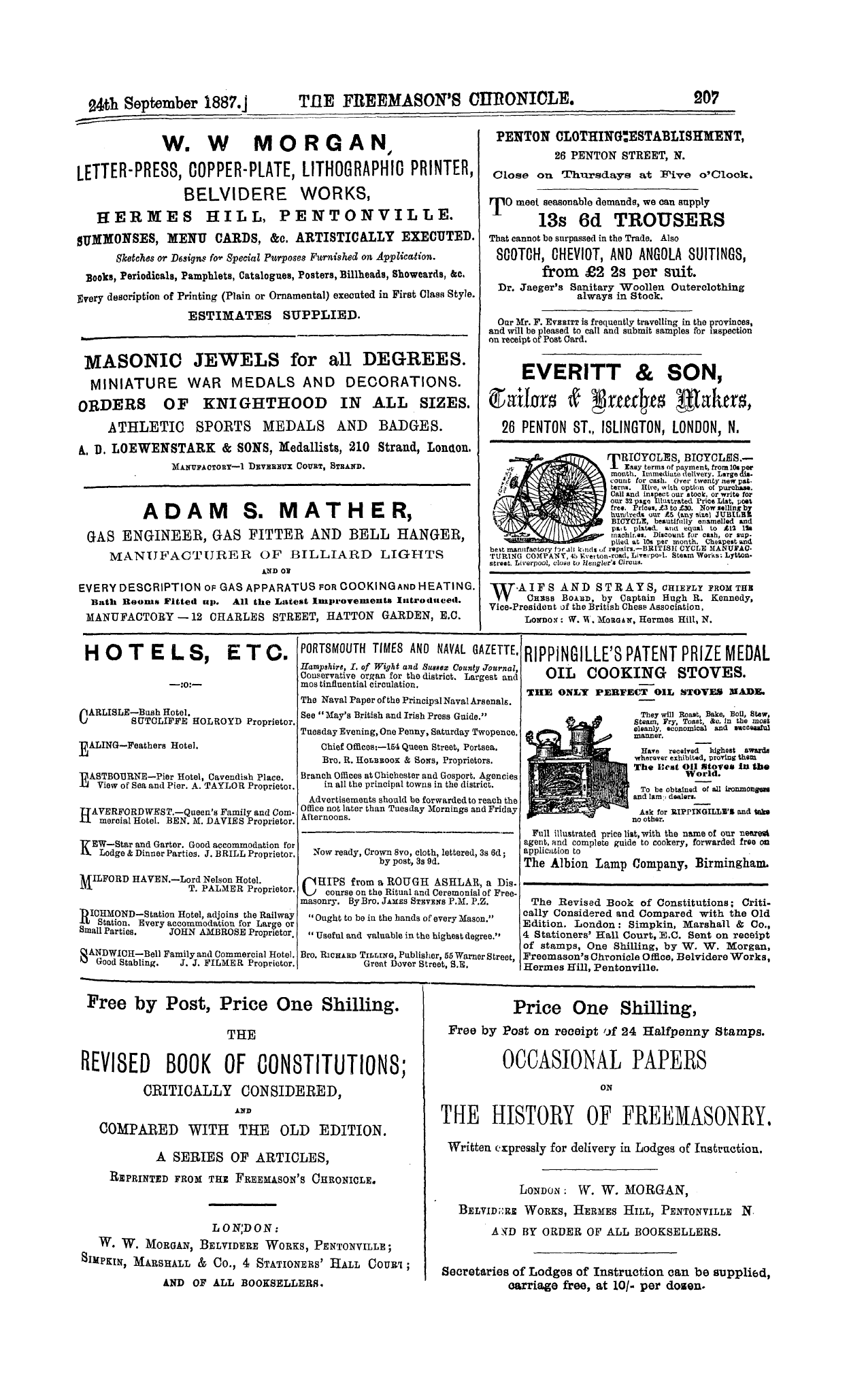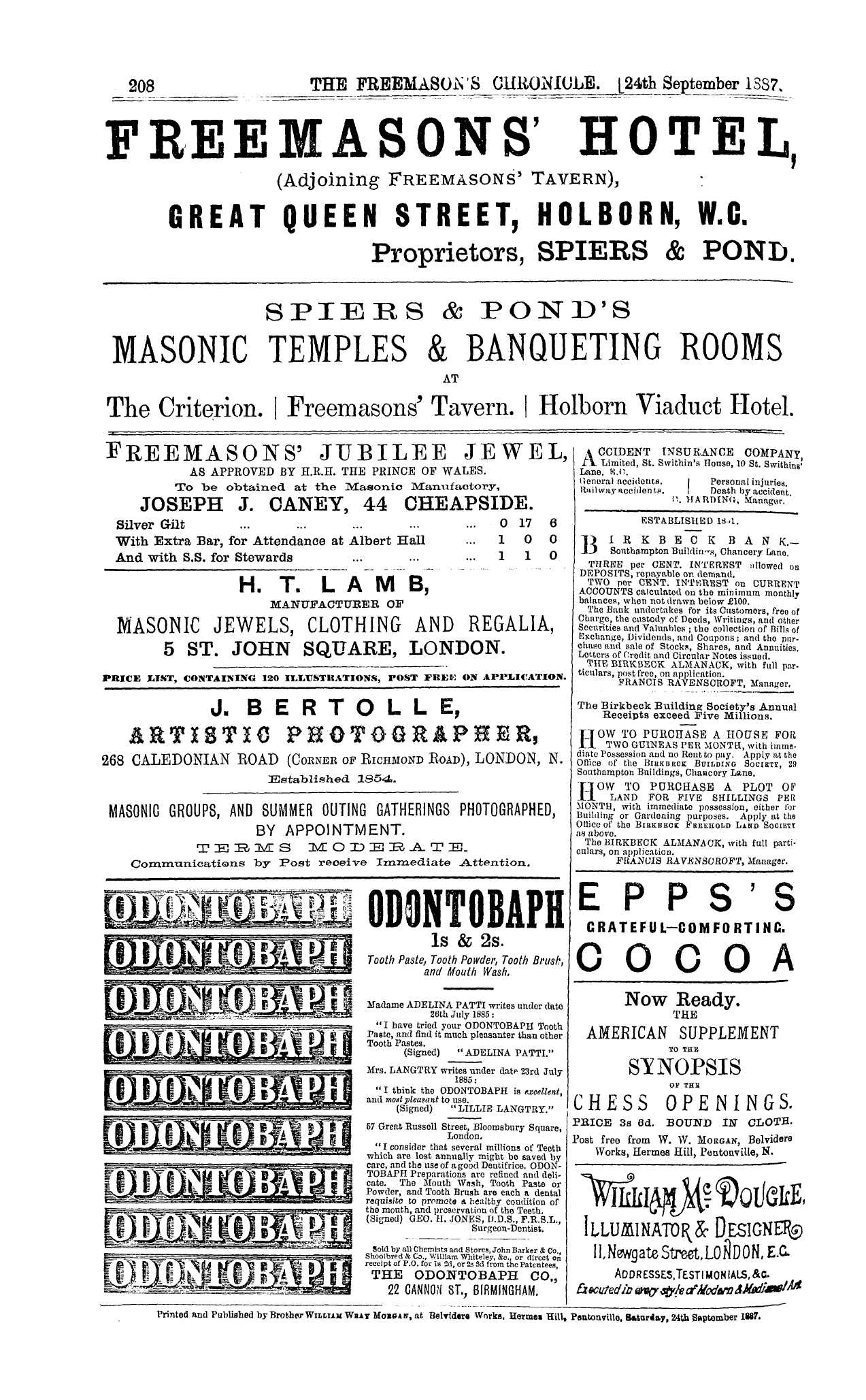-
Articles/Ads
Article THE HISTORY OF FREEMASONRY. ← Page 2 of 2 Article MASONRY AND THE AGE. Page 1 of 2 Article MASONRY AND THE AGE. Page 1 of 2 →
Note: This text has been automatically extracted via Optical Character Recognition (OCR) software.
The History Of Freemasonry.
tarn up we practically write in fche dark concerning them ; all we can put forward at the best is supposition , however ingenious , plausible , and probable .
We need not however despair ; what has been achieved ia an omen , striking and favourable , of what may yet be brought about , and time and circumstances , in some propitious hour , or by some unexpected clue , may yet reveal to
us what has been so long sought , but so far has not been discovered .
Another difficulty we have to contend with is the persistence , the endurance of error . Statements are repeated , week by week , which research has shown to be idle fable . Twice slain , as some cherished "fads" are , their survival is sometimes almost too
provoking-We publish elsewhere a contribution , written 12 years ago , by Bro . D . M . Lyon , the very able Grand Secretary of
the Grand Lodge of Scotland , which happily deals with an old "myth , " once very often propounded with almost reckless audacity , and not altogether exploded yet . We refer our readers to it . Bro . D . M . Lyon , in his clear
and succinct verbiage , disposes once and for ever of the oft-repeated allegation , thafc " Old Mother Kilwinning " ever was in any form the " faufcor" or founder of the Templar movement , or any High Grade movement emanating therefrom . It will be seen from his veracious statement
how a Craft Lodge , admittedly warranted by Mother Kilwinning only as a Craft Lodgo , took upon itself to grant High Grade Warrants of different kinds and certificates ,
& c . Let us hope and trust then , despite errors and difficulties of all kinds , that Masonic History will hold its own , and continne to be History , nofc a chaotic conglomeration of ill assorted and even contradictory myths .
Masonry And The Age.
MASONRY AND THE AGE .
IS ifc permissible to declare that the prime truths of all proper morals are involved in the recognised teachings
of Ancient Craft Masonry ? Manifestly , they are , or they are nofc . If they are , they must of necessity be fche veritable chief good of all that is to be found in the Craft of the
Lodge ; however excellent in their kind may be the other things which are parts of Masonry . If they are not , or , being found there , if they do not hold the highest place , then Masonry itself lacks the essential element of any
system which can justly claim that it is doing something for humanity . If this is not its claim , does it then claim to do anything for the benefit of its own votaries ? And if it does this , what is it ?
We all know that the claim of Masonry is not only to teach the highest truths known to the whole circle of
sublime morality , bufc to inculcate them by means of lessons contrived to be of greater simplicity and more lasting force than are to be found elsewhere . It is claimed that ifcs
symbolic representations , as sot forth with terse and wisely ordered discourse , possess a silent , but finally more impressive influence on the hearts and minds of those who come
to understand them , than aught which can be communicated by exhortation , precept or injunction , through the living voice or written page .
Indeed , if there is anything in which many Masonic champions are strong , they are men of might in soundinc before the procession the trumpet of Masonic righteousness . It is not in the least intended by this to insinuate that
hypocrites , ancient and modern , have furnished notable examples in this very exercise , and have received the recompense which the common sentiment of the human
family awards to those who run where they are not called ; nor yet that there is any such purpose in view as with those who proclaim their own wares in places where things are brought to sell , however much it may appear so to a
censorious world . Doubtless moat that we hear and read in praise of our good deeds is sincerely uttered , for being effusive on
behalf of a good fraternity is not sufficient evidence of bad intent—even in an insinuation " founded in geometry . " Bat every such claim in ifcs own behalf made earnestly or falsely by any institution , or its members , is part of the
universal testimony of tbe entire race of mankind , ancient and modern , to this , that truth , virtue , and righteousness , and their kindred excellencies—even however lacking in tho particular instance—constitute the great and proper object and end—fche veritable summum bonum—of all
Masonry And The Age.
human attainment , and that whoever , and whatever institution holds firmly to these in fact , is one to be trusted even where others fail . Indeed should Masons fail to claim for the institution ( not for the members ) the
inculcation of the most exalted virtues , it would become in the eyes of the profligate and base , to say nothing of the virtuous and manly , a thing of contempt , until its consequent extinction . Doubtless the world does and
always will worship the happy results flowing from a good reputation for virtue and morality , and it would be a blessed change if the real homage bestowed on wealth and power could be transferred to the benign virtues which receive so much of the praise and of the neglect of the
present age . Yes , we must conclude that whether sincerel y or insincerely , the world continually testifies to and reaffirms the universal judgment that without a controlling influence of moral principles society is lost ; and good
government , law , order , liberty , justice and common welfare must perish from every land ; let fche splendour of its achievements and the magnificence of its institutions be what they may . But when or where has ever been known any degree of
genuine moral life without integrity or character ? that intent of heart and mind which fastens together to be firm and strong ; and holds to the determination and the pursuit to be accomplished , for the sake of the supreme or
principal good , which lies at the very goal . But integrity of character , while it is a bond and fastening as the cement is to the walls of a building , is also a quality thereof , or at least manifests itself as such , as the solidity and firmness which characterise the well-built structure .
The lack of developing and establishing this indispeusible element of moral character as a prerequisite under all circumstances , is the fatal defect in the education and training which society now affords to its members : for
after all that may be done by parents and teachers , a part , and often the greatest part , of what the mind of man acquires is from the direct" and reflex teachings of the community surrounding him ; and this influence is
continually becoming more and more sinister and debasing in many respects . This is the natural consequence of the great development of material prosperity , the struggle for merely intellectual advance , and competition for present advantage in life .
While society presents its inventions , intrigues , devices and shams which attract so much attention because they appear to serve a present purpose , Masonry in the quiet recess of the Lodge exhibits among other things of like
character , two building stones ; one is called the rough ashlar , and the other the perfect or the perfected ashlar , and the explanation of them usually given is , that one of these stones represents the human being in its " rude and
imperfect state by nature , " and the other such a being who has undergone the proper discipline—the subjugation of selfish and wayward passions , and the cultivation of the
worthy and noble affections of good and truth . Both are , however , esteemed as proper to be wrought into a building , and each is a moveable jewel of the Lodge .
Most persons on hearing the short and incomplete explanation afforded by the ritual and monitors , think of nothing more than the improved and elegant appearance of the skilfully chiselled stone , as compared with the broken
outlines and rugged surface of the other , which bears no other trace of handiwork than the unsightly scars left by the iron gavel of the Apprentice . But there is something more . It is not merely because one of these blocks is
chiselled , o ^ even finely sculptured , that it is deemed worthy of a place in the building for whose construction the Lodge is erected , as were the operative Lodges established for the construction of great works . These ashlars are each of
proper building stone , the material is in them ; they are not substitutes or shams , composed of clay or lath and stucco or concrete ; and this is why the work bestowed on either of them is valuable , and they are deemed worthy to
be trusted in the foundation or the wall . But there is yet something more . These stones are two of the jewels of the Lodge—nofc immovable jewels , as the square , level and plumb , for these are fixed at the angles , and attached to
the course of the sun , bufc they are called movable in order to distinguish them from the others—they have no location—they do not represent truths which concern fixed
points or lines of the earth or of the courses of the celestial bodies , as the immovable , or fixed jewels do in their lower signification . But , being jewels of the Lodge , they must be deemed representatives of something more than is implied
Note: This text has been automatically extracted via Optical Character Recognition (OCR) software.
The History Of Freemasonry.
tarn up we practically write in fche dark concerning them ; all we can put forward at the best is supposition , however ingenious , plausible , and probable .
We need not however despair ; what has been achieved ia an omen , striking and favourable , of what may yet be brought about , and time and circumstances , in some propitious hour , or by some unexpected clue , may yet reveal to
us what has been so long sought , but so far has not been discovered .
Another difficulty we have to contend with is the persistence , the endurance of error . Statements are repeated , week by week , which research has shown to be idle fable . Twice slain , as some cherished "fads" are , their survival is sometimes almost too
provoking-We publish elsewhere a contribution , written 12 years ago , by Bro . D . M . Lyon , the very able Grand Secretary of
the Grand Lodge of Scotland , which happily deals with an old "myth , " once very often propounded with almost reckless audacity , and not altogether exploded yet . We refer our readers to it . Bro . D . M . Lyon , in his clear
and succinct verbiage , disposes once and for ever of the oft-repeated allegation , thafc " Old Mother Kilwinning " ever was in any form the " faufcor" or founder of the Templar movement , or any High Grade movement emanating therefrom . It will be seen from his veracious statement
how a Craft Lodge , admittedly warranted by Mother Kilwinning only as a Craft Lodgo , took upon itself to grant High Grade Warrants of different kinds and certificates ,
& c . Let us hope and trust then , despite errors and difficulties of all kinds , that Masonic History will hold its own , and continne to be History , nofc a chaotic conglomeration of ill assorted and even contradictory myths .
Masonry And The Age.
MASONRY AND THE AGE .
IS ifc permissible to declare that the prime truths of all proper morals are involved in the recognised teachings
of Ancient Craft Masonry ? Manifestly , they are , or they are nofc . If they are , they must of necessity be fche veritable chief good of all that is to be found in the Craft of the
Lodge ; however excellent in their kind may be the other things which are parts of Masonry . If they are not , or , being found there , if they do not hold the highest place , then Masonry itself lacks the essential element of any
system which can justly claim that it is doing something for humanity . If this is not its claim , does it then claim to do anything for the benefit of its own votaries ? And if it does this , what is it ?
We all know that the claim of Masonry is not only to teach the highest truths known to the whole circle of
sublime morality , bufc to inculcate them by means of lessons contrived to be of greater simplicity and more lasting force than are to be found elsewhere . It is claimed that ifcs
symbolic representations , as sot forth with terse and wisely ordered discourse , possess a silent , but finally more impressive influence on the hearts and minds of those who come
to understand them , than aught which can be communicated by exhortation , precept or injunction , through the living voice or written page .
Indeed , if there is anything in which many Masonic champions are strong , they are men of might in soundinc before the procession the trumpet of Masonic righteousness . It is not in the least intended by this to insinuate that
hypocrites , ancient and modern , have furnished notable examples in this very exercise , and have received the recompense which the common sentiment of the human
family awards to those who run where they are not called ; nor yet that there is any such purpose in view as with those who proclaim their own wares in places where things are brought to sell , however much it may appear so to a
censorious world . Doubtless moat that we hear and read in praise of our good deeds is sincerely uttered , for being effusive on
behalf of a good fraternity is not sufficient evidence of bad intent—even in an insinuation " founded in geometry . " Bat every such claim in ifcs own behalf made earnestly or falsely by any institution , or its members , is part of the
universal testimony of tbe entire race of mankind , ancient and modern , to this , that truth , virtue , and righteousness , and their kindred excellencies—even however lacking in tho particular instance—constitute the great and proper object and end—fche veritable summum bonum—of all
Masonry And The Age.
human attainment , and that whoever , and whatever institution holds firmly to these in fact , is one to be trusted even where others fail . Indeed should Masons fail to claim for the institution ( not for the members ) the
inculcation of the most exalted virtues , it would become in the eyes of the profligate and base , to say nothing of the virtuous and manly , a thing of contempt , until its consequent extinction . Doubtless the world does and
always will worship the happy results flowing from a good reputation for virtue and morality , and it would be a blessed change if the real homage bestowed on wealth and power could be transferred to the benign virtues which receive so much of the praise and of the neglect of the
present age . Yes , we must conclude that whether sincerel y or insincerely , the world continually testifies to and reaffirms the universal judgment that without a controlling influence of moral principles society is lost ; and good
government , law , order , liberty , justice and common welfare must perish from every land ; let fche splendour of its achievements and the magnificence of its institutions be what they may . But when or where has ever been known any degree of
genuine moral life without integrity or character ? that intent of heart and mind which fastens together to be firm and strong ; and holds to the determination and the pursuit to be accomplished , for the sake of the supreme or
principal good , which lies at the very goal . But integrity of character , while it is a bond and fastening as the cement is to the walls of a building , is also a quality thereof , or at least manifests itself as such , as the solidity and firmness which characterise the well-built structure .
The lack of developing and establishing this indispeusible element of moral character as a prerequisite under all circumstances , is the fatal defect in the education and training which society now affords to its members : for
after all that may be done by parents and teachers , a part , and often the greatest part , of what the mind of man acquires is from the direct" and reflex teachings of the community surrounding him ; and this influence is
continually becoming more and more sinister and debasing in many respects . This is the natural consequence of the great development of material prosperity , the struggle for merely intellectual advance , and competition for present advantage in life .
While society presents its inventions , intrigues , devices and shams which attract so much attention because they appear to serve a present purpose , Masonry in the quiet recess of the Lodge exhibits among other things of like
character , two building stones ; one is called the rough ashlar , and the other the perfect or the perfected ashlar , and the explanation of them usually given is , that one of these stones represents the human being in its " rude and
imperfect state by nature , " and the other such a being who has undergone the proper discipline—the subjugation of selfish and wayward passions , and the cultivation of the
worthy and noble affections of good and truth . Both are , however , esteemed as proper to be wrought into a building , and each is a moveable jewel of the Lodge .
Most persons on hearing the short and incomplete explanation afforded by the ritual and monitors , think of nothing more than the improved and elegant appearance of the skilfully chiselled stone , as compared with the broken
outlines and rugged surface of the other , which bears no other trace of handiwork than the unsightly scars left by the iron gavel of the Apprentice . But there is something more . It is not merely because one of these blocks is
chiselled , o ^ even finely sculptured , that it is deemed worthy of a place in the building for whose construction the Lodge is erected , as were the operative Lodges established for the construction of great works . These ashlars are each of
proper building stone , the material is in them ; they are not substitutes or shams , composed of clay or lath and stucco or concrete ; and this is why the work bestowed on either of them is valuable , and they are deemed worthy to
be trusted in the foundation or the wall . But there is yet something more . These stones are two of the jewels of the Lodge—nofc immovable jewels , as the square , level and plumb , for these are fixed at the angles , and attached to
the course of the sun , bufc they are called movable in order to distinguish them from the others—they have no location—they do not represent truths which concern fixed
points or lines of the earth or of the courses of the celestial bodies , as the immovable , or fixed jewels do in their lower signification . But , being jewels of the Lodge , they must be deemed representatives of something more than is implied















